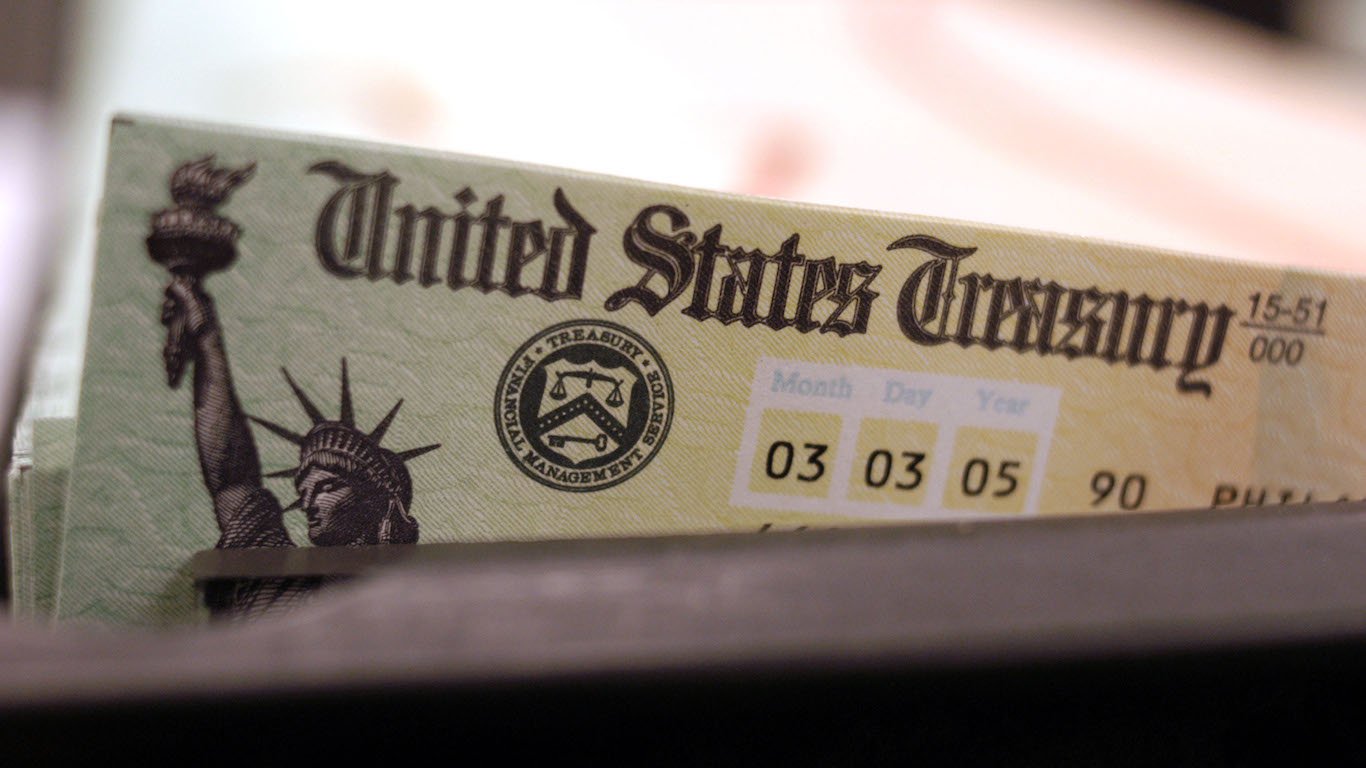

Since the creation of Temporary Assistance for Needy Families (TANF) in 1996, the program’s reach has fallen dramatically. While in its first year 68 in every 100 poor families nationwide received TANF benefits, just 23 in every 100 poor families did as of 2017.
A federal block grant, TANF provides states a great degree of flexibility in determining the generosity, restrictiveness, and duration of benefits. As a result, the TANF-to-poverty ratio varies greatly throughout the United States, from 65 in every 100 poor families receiving benefits to just 4 in every 100 families.
To determine the states where welfare supports the fewest (and the most) poor families, 24/7 Wall St. reviewed the TANF-to-poverty ratio — the number of TANF cases relative to the number of families with children living below the poverty line — from the nonpartisan research institute Center on Budget and Policy Priorities.
Each state may enact its own TANF policies, which explains the variations from state to state. Some states are less generous in the benefit amount, some more restrictive in who is eligible, and some would provide benefits for shorter duration. Each state can determine the maximum monthly amount. The average benefit for a single-parent family of three across all states is $454.
States with more wide-reaching TANF programs tend to have greater access to other public assistance programs, such as food stamps and unemployment insurance, as well. Many of the states with the highest TANF-to-poverty ratios are also among the best states to be unemployed.
TANF recipiency is also positively correlated with wealth, and states with the highest and lowest TANF recipiency ratios tend to be among America’s richest and poorest states, respectively.
Click here to see the full list of states where welfare supports the fewest (and most) poor families.
Click here to see our detailed findings and methodology.
States Where Welfare Supports the Fewest Poor Families

10. Idaho
> TANF-to-poverty ratio: 8.2 for every 100 poor families
> Median household income: $52,225 (11th lowest)
> Max. income for eligibility (family of 3): $972 per month (17th highest)
> Max. monthly benefit: $309 (16th lowest)
While nationwide 23 in every 100 poor U.S. families receive Temporary Assistance for Needy Families benefits, or welfare, just 8 in every 100 poor families do in Idaho — despite Idaho being one of the poorer states. The typical household earns approximately $8,000 less a year than the U.S. median. Similarly, just 9.7% of state residents receive food stamps, compared to 11.7% of Americans nationwide.
One likely reason for this low access level is that Idaho is one of 19 states that requires residents to be actively searching for work in order to receive welfare benefits. While Idaho exempts recipients providing full-time care to a child under 12 weeks of age from this requirement, it does not exempt those who are ill or caring for someone unable to work, as is the case in many states.
[in-text-ad]

9. Indiana
> TANF-to-poverty ratio: 7.0 for every 100 poor families
> Median household income: $54,181 (17th lowest)
> Max. income for eligibility (family of 3): $378 per month (5th lowest)
> Max. monthly benefit: $288 (12th lowest)
Indiana’s low-income families have less access to welfare today than they did 10 years ago. Recipiency fell from 27 in every 100 poor families receiving TANF benefits in 2008, back then in line with national average, to just 7 in every 100, the ninth lowest ratio of any state today. The 74% drop in recipiency represents the largest decline of any state over the period.
Two factors are contributing to low welfare recipiency Indiana. First, the maximum monthly income for a single-parent family of three to be eligible for welfare is just $378, the fifth lowest income limit of any state. Second, the total value of assets allowed for eligibility is $1,000 or less, tied with eight other states as the lowest asset limit.

8. North Carolina
> TANF-to-poverty ratio: 6.7 for every 100 poor families
> Median household income: $52,752 (13th lowest)
> Max. income for eligibility (family of 3): $681 per month (21st lowest)
> Max. monthly benefit: $272 (7th lowest)
Just 7 in every 100 poor families in North Carolina receive TANF benefits, the eighth lowest welfare recipiency ratio of any state. The welfare benefits also are less generous than in other states. The maximum benefit for a single-parent family of three is just $272 a month, the seventh lowest of any state and far below the $454 national average.
TANF is administered as a federal block grant to allow states to allocate money to different programs as they see fit. Many states, however, use TANF funds for other purposes. North Carolina spends just 42.4% of its TANF funds on what the Center on Budget and Policy Priorities deems “core activities” — basic assistance, work activities, and work supports — below the 52.2% national figure. Just 7.2% is used for basic assistance, or cash benefits, the seventh smallest share of any state.

7. Arizona
> TANF-to-poverty ratio: 6.1 for every 100 poor families
> Median household income: $56,581 (23rd lowest)
> Max. income for eligibility (family of 3): $585 per month (15th lowest)
> Max. monthly benefit: $278 (8th lowest)
Over the last 10 years, the TANF-to-poverty ratio in Arizona fell from 22 in every 100 poor families receiving welfare to just 6 in every 100 poor families, the second largest decline of any state over the period.
One factor contributing to the decline in welfare recipiency is the reduction in the maximum duration for which state residents are allowed to receive TANF benefits. While federal law limits TANF assistance to a maximum duration of 60 months, some states impose shorter limits. In 2016, Arizona cut its time limit from 24 to just 12 months, now the shortest maximum duration of any state.
[in-text-ad-2]

6. Mississippi
> TANF-to-poverty ratio: 5.9 for every 100 poor families
> Median household income: $43,529 (2nd lowest)
> Max. income for eligibility (family of 3): $457 per month (9th lowest)
> Max. monthly benefit: $170 (the lowest)
While nationwide the TANF-to-poverty ratio fell 19.0% over the past 10 years, in Mississippi it fell 51.3% — the 10th largest decline of any state. Today, just 6 in every 100 poor families in Mississippi receive TANF benefits, a lower ratio than in all but five states.
In addition to their limited reach, welfare benefits in Mississippi are less generous than in other states. The maximum monthly TANF benefit for a single-parent family of three is just $170, far less than the $454 national average and the lowest of any state — even when adjusted for Mississippi’s low cost of living.

5. Georgia
> TANF-to-poverty ratio: 5.9 for every 100 poor families
> Median household income: $56,183 (19th lowest)
> Max. income for eligibility (family of 3): $514 per month (11th lowest)
> Max. monthly benefit: $280 (9th lowest)
Just 6 in every 100 poor families in Georgia receive TANF benefits, the fifth lowest ratio of any state. Two factors partially explain the low welfare recipiency is the state. To be eligible for TANF benefits in Georgia, a single-parent family of three must make no more than $514 a month, the 11th lowest income limit of any state and far below the $881 national average. Additionally, while a majority of states allow residents to receive TANF benefits for a maximum of 60 months, Georgia limits its recipients to 48 months.
While state TANF policies are race neutral, states with low welfare recipiency tend to have disproportionately large minority populations. In Georgia, 31.1% of the population is African American, the third largest share of any state.
[in-text-ad]

4. Wyoming
> TANF-to-poverty ratio: 5.6 for every 100 poor families
> Median household income: $60,434 (19th highest)
> Max. income for eligibility (family of 3): $1,259 per month (11th highest)
> Max. monthly benefit: $660 (5th highest)
While the TANF-to-poverty ratio increased more in Wyoming than in any state other than Colorado over the past 10 years — from 3 families on welfare for every 100 poor families to 6 in every 100 — it is still the fourth lowest ratio of any state today. Similarly, just 6.3% of Wyoming residents receive SNAP, or food stamp benefits, tied as the smallest share nationwide and far less than the 11.7% national recipiency rate.
While states with lower access to TANF tend to also have less generous benefits, Wyoming has one of the highest benefit caps in the country. An eligible single-parent family of three can receive up to $660 a month in TANF benefits, more than the $454 national average and the fifth highest maximum monthly benefit of any state.

3. Arkansas
> TANF-to-poverty ratio: 4.6 for every 100 poor families
> Median household income: $45,869 (3rd lowest)
> Max. income for eligibility (family of 3): $278 per month (3rd lowest)
> Max. monthly benefit: $204 (3rd lowest)
Just 5 in every 100 families living below the poverty line in Arkansas receive TANF benefits, the third lowest such figure of any state and far below the national ratio of 23 in every 100 poor families.
Two factors impacting welfare recipiency in Arkansas are the state’s low income limit and short maximum benefit duration. In Arkansas, the maximum income for initial eligibility is just $278, the lowest of any state, and well below the $881 nationwide average maximum. Additionally, Arkansas limits its recipients to 24 months of benefits, the shortest maximum duration of any state other than Connecticut and Arizona and well below the 60 month federal limit.

2. Texas
> TANF-to-poverty ratio: 4.4 for every 100 poor families
> Median household income: $59,206 (23rd highest)
> Max. income for eligibility (family of 3): $401 per month (7th lowest)
> Max. monthly benefit: $286 (11th lowest)
Just 4 in every 100 poor families in Texas receive TANF benefits, the second lowest ratio of any state and far below the national figure of 23 in every 100 poor families. One reason for the low welfare recipiency in Texas may be the state’s income and asset limits. To be eligible for TANF benefits in Texas, a single-parent family of three must earn no more than $401 a month, far below the national average maximum of $881 and the seventh lowest of any state.
In addition to income, most states determine eligibility for public benefit programs according to the total value of assets in one’s possession. In Texas, residents are only eligible for welfare if they own $1,000 or less in assets, tied with eight other states as the lowest asset limit in the country.
[in-text-ad-2]

1. Louisiana
> TANF-to-poverty ratio: 3.9 for every 100 poor families
> Median household income: $46,145 (4th lowest)
> Max. income for eligibility (family of 3): $360 per month (4th lowest)
> Max. monthly benefit: $240 (5th lowest)
Some 19.7% of the population of Louisiana lives below the poverty line, a higher poverty rate than any state other than Mississippi. Just 4 in every 100 poor families in the state receive TANF benefits — the lowest ratio of any state and far below the national ratio of 23 in every 100. One factor contributing to the state’s low welfare recipiency is the low income cap for TANF recipients of just $360, the fourth lowest of any state. Nationwide, the average single-parent family of three can earn up to $881 a month.
While state TANF policies are race neutral, states with low TANF-to-poverty ratios tend to have disproportionately large minority populations. In Louisiana, 32.1% of the population is African American, the second largest share of any state.
States Where the Most Poor Families Receive Welfare

10. Colorado
> TANF-to-poverty ratio: 33.6 for every 100 poor families
> Median household income: $69,117 (11th highest)
> Max. income for eligibility (family of 3): $511 per month (10th lowest)
> Max. monthly benefit: $462 (23rd highest)
While nationwide the TANF-to-poverty ratio fell 19.0% nationwide over the past 10 years, it nearly tripled in Colorado. Welfare recipiency rose from 12 in every 100 poor families in 2009 to 34 in every 100 poor families today, the largest increase of any state over the period. The TANF-to-poverty ratio in Colorado is now the 10th highest of any state and is far higher than the national rate of 23 in every 100 poor families receiving TANF benefits.
Colorado is also one of only eight states that imposes no asset limit for welfare recipients. The state also has no job-seeking requirements, and it follows the federally set maximum benefits duration of 60 months.
[in-text-ad]

9. Oregon
> TANF-to-poverty ratio: 35.3 for every 100 poor families
> Median household income: $60,212 (20th highest)
> Max. income for eligibility (family of 3): $616 per month (16th lowest)
> Max. monthly benefit: $506 (17th highest)
For every 100 poor families in Oregon, 35 receive TANF benefits — the ninth highest TANF-to-poverty ratio of any state. Oregon has a strong history of labor rights and policies that protect workers, and the state has worked to increase the access to TANF even as many states enacted more restrictive policies. While nationwide the TANF-to-poverty ratio fell 19.0% over the past 10 years, in Oregon it rose 7.7% — the ninth largest increase of any state over the period.
Similarly, while the state’s poverty rate is roughly in line with the nation as a whole, 15.4% of residents receive SNAP benefits, more than the 11.7% national share and the fourth highest recipiency rate of any state.

8. Delaware
> TANF-to-poverty ratio: 35.9 for every 100 poor families
> Median household income: $62,852 (17th highest)
> Max. income for eligibility (family of 3): $428 per month (8th lowest)
> Max. monthly benefit: $338 (17th lowest)
In Delaware, 36 in every 100 poor families receive TANF benefits, the eighth highest welfare recipiency ratio of any state. States with the highest TANF-to-poverty ratios tend to have policies that reduce barriers to welfare eligibility. In Delaware, for example, residents can own up to $10,000 in assets and still be eligible for TANF benefits, tied with Minnesota as the highest asset limit in the country.
TANF is administered as a federal block grant to allow states to allocate money to different programs as they see fit. Many states, however, use TANF funds for other purposes. On average, states spend just 52.2% of TANF funds on what the Center on Budget and Policy Priorities deems “core activities” — basic assistance, work activities, work supports, and child care. Delaware, however, spends 80.3% of its TANF funds on core activities, the third largest share of any state.

7. Massachusetts
> TANF-to-poverty ratio: 37.9 for every 100 poor families
> Median household income: $77,385 (4th highest)
> Max. income for eligibility (family of 3): $818 per month (25th lowest)
> Max. monthly benefit: $618 (8th highest)
In Massachusetts, 38 in every 100 poor families receive TANF benefits, the seventh highest TANF-to-poverty ratio of any state and far higher than the national figure of 23 in every 100 poor families. States with the highest TANF-to-poverty ratios tend to also have more generous welfare benefits. In Massachusetts, the maximum monthly benefit for a single-parent family of three is $618, far greater than the $454 national average and the eighth highest of any state.
Similarly, federal law limits TANF assistance to a maximum duration of 60 months, but also allows states to extend this limit with state-funded programs, or shorten it. Massachusetts is one of only two states in which recipients can continue to receive benefits after 60 months.
[in-text-ad-2]

6. Hawaii
> TANF-to-poverty ratio: 38.0 for every 100 poor families
> Median household income: $77,765 (3rd highest)
> Max. income for eligibility (family of 3): $1,740 per month (2nd highest)
> Max. monthly benefit: $610 (10th highest)
In Hawaii, 38 in every 100 poor families receive TANF benefits, the sixth highest welfare recipiency ratio in the country and higher than the nationwide ratio of 23 in 100. States with the highest recipiency ratios tend to have policies that reduce barriers to welfare eligibility. In Hawaii, a single-parent family of three can earn up to $1,740 a month and still be eligible for welfare, the second highest income limit of any state and nearly twice the $881 national average. Hawaii is also one of eight states that do not have an asset value limit for welfare eligibility.
States with more Democratic lawmakers than Republicans tend to have more generous and less restrictive TANF policies. In Hawaii, Democrats occupy 92.1% of seats in the House and Senate, the largest share of any state.

5. Maryland
> TANF-to-poverty ratio: 38.9 for every 100 poor families
> Median household income: $80,776 (the highest)
> Max. income for eligibility (family of 3): $810 per month (22nd lowest)
> Max. monthly benefit: $648 (6th highest)
In Maryland, 39 in every 100 poor families receive TANF benefits, the fifth highest welfare recipiency ratio nationwide. States with higher TANF-to-poverty ratios tend to have policies that reduce the barriers for welfare eligibility. While a majority of states disqualify those with assets above a certain total value from receiving welfare — ranging from $1,000 to $10,000 — Maryland is one of eight states with no asset limit. States with greater access to welfare also tend to have more generous benefits, and in Maryland the maximum benefit for a single-parent family of three is $648 a month — the sixth highest of any state.
[in-text-ad]

4. New York
> TANF-to-poverty ratio: 42.2 for every 100 poor families
> Median household income: $64,894 (14th highest)
> Max. income for eligibility (family of 3): $879 per month (21st highest)
> Max. monthly benefit: $789 (3rd highest)
While nationwide 23 in every 100 poor families receive TANF benefits, 42 in every 100 poor families do in New York, the fourth highest welfare recipiency ratio in the country. States with the highest TANF-to-poverty ratios tend to also have more generous welfare benefits. In New York, the maximum monthly benefit for a single-parent family of three is $789, far greater than the $454 national average and the third highest of any state and the fifth highest when adjusted for New York State’s high cost of living.
And while a majority of states offer TANF benefits for a federally-set maximum of 60 months, states can either extend this limit with state funds or impose a shorter limit. New York is one of only two states in which eligible individuals can continue to receive benefits after 60 months.

3. Minnesota
> TANF-to-poverty ratio: 47.1 for every 100 poor families
> Median household income: $68,388 (12th highest)
> Max. income for eligibility (family of 3): $2,243 per month (the highest)
> Max. monthly benefit: $532 (15th highest)
In Minnesota, 47 in every 100 poor families receive TANF benefits, the highest welfare recipiency ratio of any state other than Vermont and California. States with higher TANF-to-poverty ratios tend to have less restrictive welfare policies. While nationwide the average single-parent family of three can only earn up to $881 a month and still be eligible for TANF, in Minnesota the maximum monthly income for initial eligibility is $2,243, the highest of any state.
In addition to income, most states determine eligibility for public benefit programs according to the total value of assets in one’s possession. In Minnesota, residents can own up to $10,000 in assets and still be eligible for welfare, tied with Delaware as the highest asset limit of any state with some limit in place.

2. Vermont
> TANF-to-poverty ratio: 54.6 for every 100 poor families
> Median household income: $57,513 (24th lowest)
> Max. income for eligibility (family of 3): $1,103 per month (12th highest)
> Max. monthly benefit: $640 (7th highest)
For every 100 poor families in Vermont, 55 receive TANF benefits — more than twice the national ratio of 23 in every 100 poor families receiving TANF and the second highest of any state. Two factors contribute to Vermont’s high TANF-to-poverty ratio. In Vermont, a single-parent family of three can earn up to $1,103 a month and still be eligible for TANF benefits, greater than the national average income limit of $881 and the 12th highest of any state. Additionally, individuals can own up to $9,000 in assets, the third highest asset limit.
States with less restrictive welfare policies also tend to have more generous benefits. In Vermont, the maximum monthly benefit for a single-parent family of three is $640, more than the $454 national average and the seventh highest of any state.
[in-text-ad-2]

1. California
> TANF-to-poverty ratio: 65.3 for every 100 poor families
> Median household income: $71,805 (8th highest)
> Max. income for eligibility (family of 3): $1,431 per month (6th highest)
> Max. monthly benefit: $714 (4th highest)
In California, there are 65 families receiving TANF benefits for every 100 poor families — by far the highest ratio of any state and nearly triple the national ratio of 23 in every 100. One factor contributing to the state’s high welfare recipiency is the high income cap for TANF recipients of $1,431 for a single-parent family of three, the sixth highest of any state. Nationwide the maximum is $881.
According to the nonprofit Urban Institute, states with a greater proportion of Democrats in government tend to have more generous and less restrictive TANF policies. Democrats occupy one of the largest shares of House and Senate seats in California compared to any state.
Methodology
To determine the states where welfare supports the fewest (and the most) poor families, 24/7 Wall St. reviewed the TANF-to-poverty ratio — the number of TANF cases relative to the number of families with children living below the poverty line — from the nonpartisan research institute Center on Budget and Policy Priorities (CBPP) for the years 2016 and 2017. Data on maximum income for initial eligibility and the maximum monthly benefit for single-parent families of three is also from the CBPP and are two-year averages for 2016-2017. Data on state category spending is from the CBPP and is as of 2017. Asset limits and work requirements are from the Welfare Rules Databook of the nonprofit think tank Urban Institute and are as of July 2017. Data on median household income, the percentage of individuals living in poverty, the percentage of households receiving SNAP, or food stamps, benefits, the percentage of individuals without health insurance, and racial composition comes from the U.S. Census Bureau’s 2017 American Community Survey. Regional price parity for goods and services figures are from the U.S. Bureau of Economic Analysis and are as of 2017. Data on the partisan composition of the state legislature is from the National Conference of State Legislatures and are as of 2017. All data are for the most recent period available.
Essential Tips for Investing: Sponsored
A financial advisor can help you understand the advantages and disadvantages of investment properties. Finding a qualified financial advisor doesn’t have to be hard. SmartAsset’s free tool matches you with up to three financial advisors who serve your area, and you can interview your advisor matches at no cost to decide which one is right for you. If you’re ready to find an advisor who can help you achieve your financial goals, get started now.
Investing in real estate can diversify your portfolio. But expanding your horizons may add additional costs. If you’re an investor looking to minimize expenses, consider checking out online brokerages. They often offer low investment fees, helping you maximize your profit.
Thank you for reading! Have some feedback for us?
Contact the 24/7 Wall St. editorial team.
 24/7 Wall St.
24/7 Wall St. 24/7 Wall St.
24/7 Wall St. 24/7 Wall St.
24/7 Wall St.
